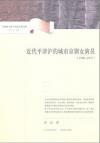
Zhang Yuan 张远
Taiyuan: Shanxi jiaoyu chubanshe, 2011
Reviewed by Wei Bingbing (Department of History, National University of Singapore)
Zhang Yuan’s Actresses of Peking Opera in Modern Beijing, Tianjin, and Shanghai, 1900-1937 is the first book-length work, in both Chinese and English scholarship, exclusively about actresses of Peking opera in modern China. Female drama players had appeared in China by the Tang dynasty, if not earlier, and blossomed in the late-Ming and early-Qing periods. Due to prohibitions by the Qing government thereafter, however, actresses of Peking opera, a genre that took shape in the mid-Qing era, did not appear until the late nineteenth century. In the early twentieth century, Peking opera actresses thrived in several large cities, and some of them even became nationally famous. This book is a comprehensive study of this special social group, including their lives and careers, the perception that critics and the public had of them, and their interaction with elite patrons. It focuses on actresses in three metropolises, namely Beijing, Tianjian, and Shanghai, not just because these sites were China’s leading centers of Peking opera entertainment at that time, but also because these cities constituted the most important route along which the actresses travelled and performed.
Following the introductory chapter, the second chapter provides a sketch of the actresses’ socioeconomic situations, including their family backgrounds, the process through which they became professional players, their training and performing in the theater world, and even their marriages. Coming from poor families, most actresses chose the profession for economic reasons. However, they were faced with various disadvantages in the theater world, which had long been dominated by actors. The third chapter investigates how the actress was perceived in the theater world and urban society. Due to conventional thoughts, the distinction between actresses and prostitutes was ambiguous; their appearance on the stage often aroused controversy, and joint performances by actors and actresses tend to be viewed by the public as erotic; meanwhile in the eyes of drama critics, actresses were in general inferior to actor in terms performing skills. The fourth chapter continues the discussion by exploring the construction of the actress’s offstage image in public media. A famous actress’s private life, literacy, morality, and even gender image, often came to be hot topics of public media, and relevant reports and discussions revealed the public’s perception and expectation of actresses. Chapter five focuses on the relationship between actresses and elite patrons, or more specifically, pengjue jia 捧角家 (player boosters). It analyzes the boosters’ mentality, activities, and their positive and negative influences on the actresses’ careers and lives.
In the concluding chapter, Zhang probes into Peking opera actresses’ social and professional situations from the perspective of the gender history of modern China. Zhang points out that by becoming actresses, many women not only managed to make a living by themselves but also became public figures. However, due to various disadvantages, the actresses lacked discursive rights and subjectivity in both the theater world and urban society. Their multiple images as party girls, intelligent and virtuous women, and professional opera players, were mainly constructed and defined by men. All these above, Zhang argues, reflect the complex situations with which China’s earliest female professionals were faced. Meanwhile, Zhang proposes a few topics regarding actresses that were not profoundly explored in the book and await further research, such as the social reception of actresses, their impact on the performing skills of Peking opera, and the player boosters as a community. Despite a few small gaps that the author identifies in the conclusion, this is generally a well-researched and clearly written book which enriches our understanding of the urban social and cultural history of modern China.
